Pressing and closing down
This session is all about individual players closing down the opposition when they have the ball. I have developed this session over the years and the players enjoy it because of the intensity. They like it because they learn the group triggers of when to close the ball down and also because it leaves them with a feeling that they are in control as a team, even when the opposition have the ball.

| Area | Up to full pitch |
| Equipment | Balls, bibs, cones, 2 full size goals |
| No. of Players | Up to 20 players + 2 goalkeepers |
| Session Time |
Pressing practice: 15mins Closing down practice: 25mins 11v11 game: 30mins |
This session is all about individual players closing down the opposition when they have the ball. I have developed this session over the years and the players enjoy it because of the intensity. They like it because they learn the group triggers of when to close the ball down and also because it leaves them with a feeling that they are in control as a team, even when the opposition have the ball.
The reason why I love this session is because we are able to demand a very high intensity performance from the players; and during the rest periods you can be very specific in getting your coaching points across.
For me, this session is a fundamental part of how my teams play when the opposition have the ball. I would normally run this session once a week and the pressing triggers would change as a part of a tactical game plan, depending on who our next opponent was.
What do I get the players to do?
Pressing practice
We set up a playing area of 40x20 yards, split into two boxes. We’re using 18 outfield players, split into three teams of six. One team starts around the inside edges of one box, one team starts around the inside edges of the other box and the third team is split into two end servers, two pressers and two waiting players.
A server starts play by passing into one box and the team in that box should pass to keep possession under pressure from the two pressing players, who try to get a touch on the ball, as shown [1a].
1a
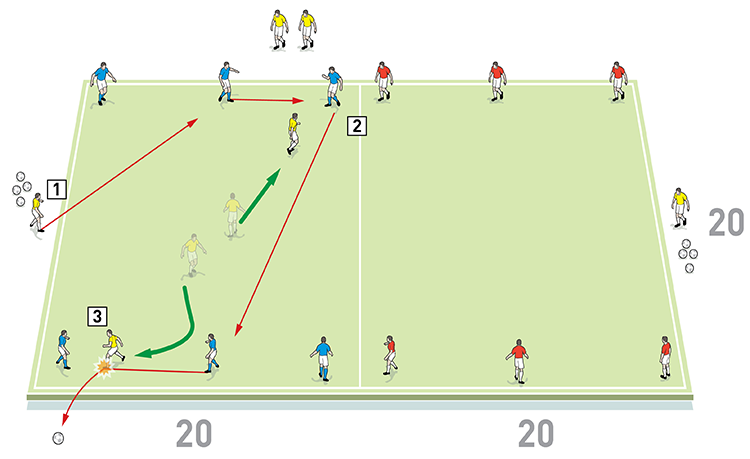
2. The blue possession team should pass to keep the ball
3. The aim for the two yellow pressing players is simply to get a touch on the ball
Once the pressers have touched the ball, the outside server at the other end serves a ball into the team in his box and the pressers must switch boxes, as shown [1b], and try to get a touch on the new ball.
1b
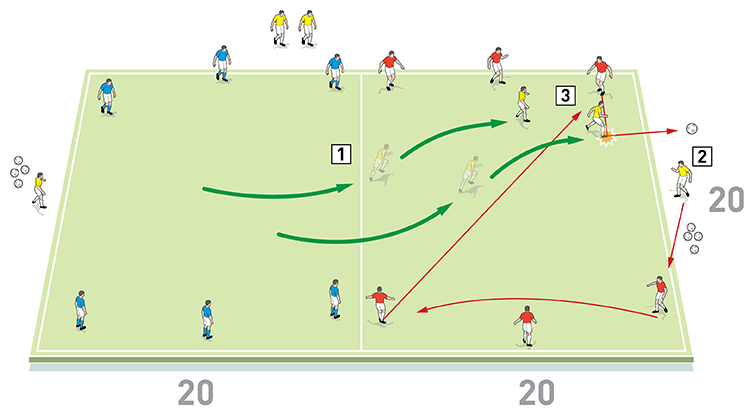
2. The outside server passes a new ball into the red team at his end and they must pass to keep possession
3. The pressing players must get to the ball as quickly as possible and try to get a touch on it again
Once the pressers touch the ball again, they return to the first box and press a third ball that has been passed into the box by the server. When the pressers get a touch on the third ball, they are finished and they must quickly switch places with either the waiting players or the end players, as shown [1c]. Play continues until all three pairs have been pressers. Then the three teams rotate roles clockwise, so each team experiences pressing.
1c
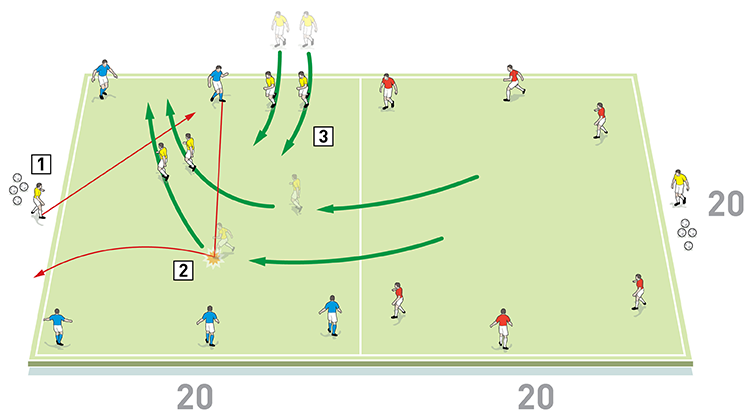
2. Once the yellow pressers have touched the ball at the other end, they quickly return to the first box ready to press again
3. If the pressing players get a touch on the third ball, they switch places with two of their team mates and play continues until everyone has experienced the pressing role
For this practice to work, we want to see the pressing players getting to the ball at pace, with the closest player pressing first. The covering player should always communicate and the pressing players mustn’t be split; in other words, they should not let the ball be passed between them.
Closing down practice
We set up between the penalty boxes with the playing area divided into thirds. A goalkeeper stands at each end but he must remain in the ‘D’ of the penalty area. We’re using 20 outfield players split into two teams of 11 including keepers. We play an 11v11 game with the players limited to three-touch. To finish, players must use a one-touch shot into the keeper’s hands without the ball bouncing.
Play starts with the coach passing to one of the goalkeepers and his team now have possession and they should try to score by passing to the keeper at the other end, but the defending team cannot press until the keeper has played to one of the defenders in the first third, as shown [2a]. When the defending team don’t have possession, they can squeeze up to the line of the first third to play the opposition offside. If the attacking team scores, the opposition keeper plays long back to the four opposition defenders who drop into their defensive third to receive, as shown [2b], and the sequence then starts again, with the attacking team building up play and trying to score.
2a
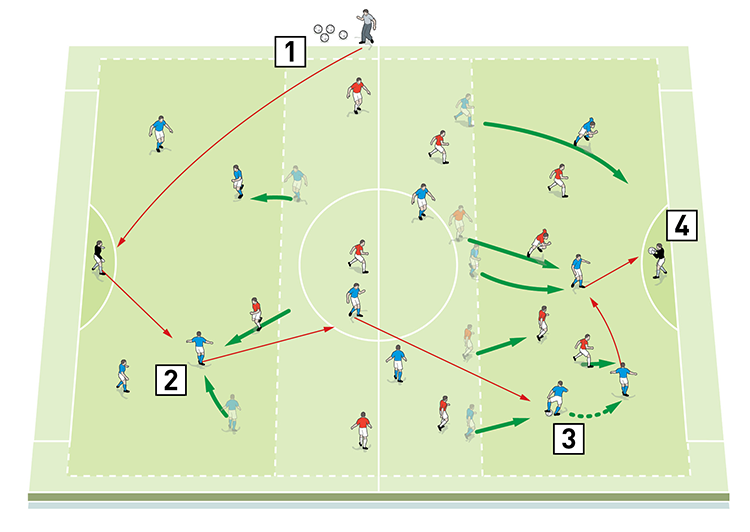
2. The red defending team cannot press until the keeper has played to one of the attacking team’s defenders in the first third
3. Players are restricted to three-touch
4. To score, players must use a one-touch shot into the opposition keeper’s hands without the ball bouncing
2b
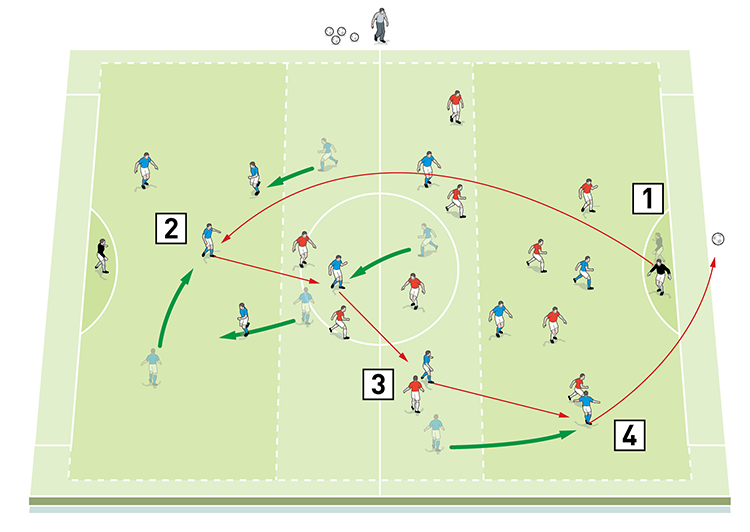
2. The four opposition defenders drop into their defensive third to receive and start to build an attack from the back
3. The red defending team try to closedown quickly to stop the attackers playing the ball to the keeper
4. Here the attackers have been shown outside and the shot misses the keeper
If the attacking team fails to hit the keeper or the ball bounces or goes out of play, the coach serves to the defending team’s keeper and the previous attackers have to drop into the middle zone until the defenders in the team now in possession touch the ball in the first third, as shown [2c].
2c
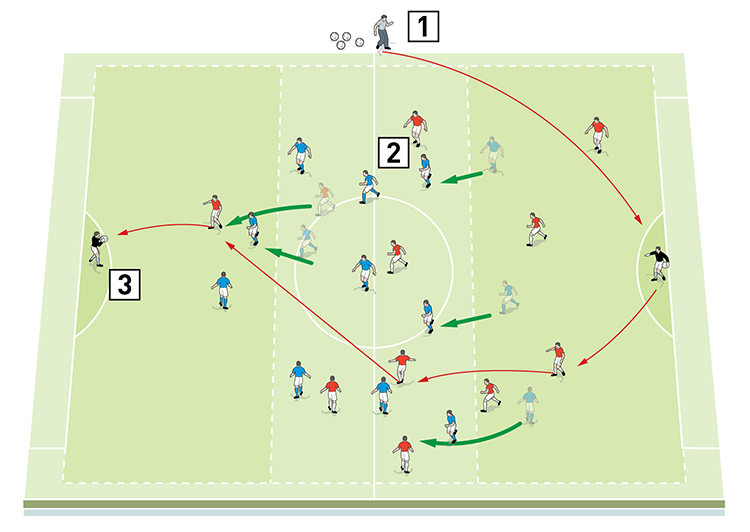
2. Having just lost possession, the blues now have to drop into the middle zone until the keeper in the team now in possession has passed to his team mates in the first third
3. The reds now attack and score by passing first-time into the hands of the opposition keeper
We want to see the defending players putting immediate pressure on any player that has his head up after receiving the ball, otherwise the opponent will find it easy to hit the keeper with his first touch and score. The defending team should keep showing the possession players outside in order to make the play predictable, so the second player pressing can read the second pass. Players should work together when pressing and if the opposition player is about to play long, the two centre backs should both drop off to screen the keeper and intercept the attempt or head clear.
We play four games of five minutes with one minute’s rest between.
How would I put this into a game situation?
11v11 game
We keep the middle zone lines from the previous practice but open the remaining playing area out to full pitch, with a goal and a goalkeeper at each end. The lines are kept as a guide to the players for a high block. The game starts with the coach serving into the keeper of the attacking team, who build up play and must try to score under pressure from the defending team, as shown [3]. It’s a normal 11v11 game with offsides but there are no throw-ins. Every time the ball goes out of play or a team scores a goal, the coach starts play again by serving into the same keeper that started the game.
3
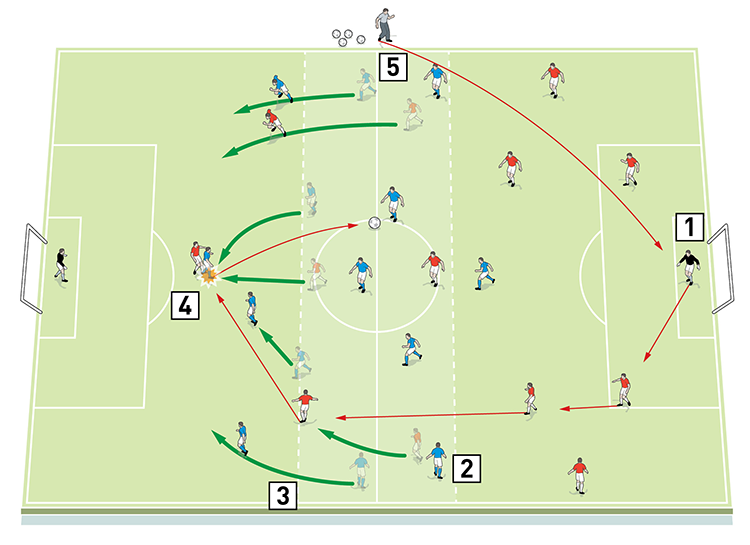
2. The blue front three should drop off to encourage the red keeper to throw out
3. The blue defending team uses the white line as a guide for a high block
4. The blue right winger and right back force play inside to set a trap for the reds. The position of the blue right back means the red left winger cannot go outside to cross, meaning the ball goes more central and is easily dealt with by the centre backs, who press the striker
5. Every time the ball goes out of play or a team scores, the coach starts play again by serving into the same keeper
By repeating a high block set-up, it incorporates all the coaching points from the previous practices and lets the coach step in and coach the defending team if the possession team get out of their half and launch an attack.
We would get the opposition front three to drop off to encourage the keeper to throw out. The coach decides who and where we want to press. In this example of a high block, we normally decide to start the high block when the opposition centre back gets the ball. It’s very important that, as coaches, we explain what side of the pitch we would prefer to start the high press/block.
We play four games of seven minutes with one minute’s rest between.
What are the key things to look for?
Technically and tactically, this is a very demanding session because the players have to work very hard when closing the ball down. It’s also very tiring mentally as players have to be very attentive and be in sync with their team mates in order to win the ball back. For example, one player might close the ball down knowing that he is not going to win it but that he is going to force the opponent to pass to a certain player that the defending team dictates. The second player might also close down knowing that he is not going to win the ball but he forces the opposition to play the ball into an area where the defending team has set a ‘trap’ and then the ball is won back and the defending team can now attack from the transition of possession.
What are the typical mistakes players might make and how do I avoid them?
Players will make mistakes when closing the ball down, both in the speed that they close down and the angle they close down. I let this happen because then we can have a coaching intervention and show the players what timing and angle would make the press better.
Normal mistakes would be closing down an opposition player in a position that would allow the opponent to play left or right. This then makes it harder for the second or third player to set a trap and makes it easier for the opposition to keep the ball. Once the triggers have been shown and explained to the players, it is much easier to dictate to the opposition where we, as a defending team, want the attackers to go. By making play predictable when we don’t have the ball, this makes defending and intercepting the ball easier.
Editor's Picks
Attacking transitions
Deep runs in the final third
Using the goalkeeper in build-up play
Intensive boxes drill with goals
Penetrating the final third
Creating and finishing
My philosophy
Pressing initiation
Compact team movement
Coaches' Testimonials

Alan Pardew

Arsène Wenger

Brendan Rodgers

Carlos Carvalhal

José Mourinho

Jürgen Klopp

Pep Guardiola

Roy Hodgson

Sir Alex Ferguson

Steven Gerrard
Coaches' Testimonials

Gerald Kearney, Downtown Las Vegas Soccer Club

Paul Butler, Florida, USA

Rick Shields, Springboro, USA

Tony Green, Pierrefonds Titans, Quebec, Canada
Join the world's leading coaches and managers and discover for yourself one of the best kept secrets in coaching. No other training tool on the planet is written or read by the calibre of names you’ll find in Elite Soccer.
In a recent survey 92% of subscribers said Elite Soccer makes them more confident, 89% said it makes them a more effective coach and 91% said it makes them more inspired.
Get Monthly Inspiration
All the latest techniques and approaches
Since 2010 Elite Soccer has given subscribers exclusive insight into the training ground practices of the world’s best coaches. Published in partnership with the League Managers Association we have unparalleled access to the leading lights in the English leagues, as well as a host of international managers.
Elite Soccer exclusively features sessions written by the coaches themselves. There are no observed sessions and no sessions “in the style of”, just first-hand advice delivered direct to you from the coach.









